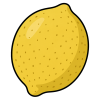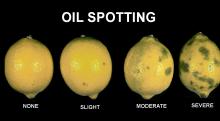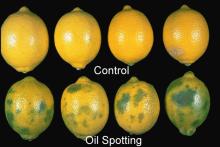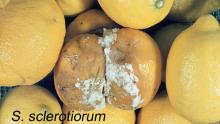Product Description
Maturity and Quality
A minimum juice content by volume of 28 or 30% depending on grade; color lemons picked at the dark-green stage have the longest postharvest life while those picked fully-yellow must be marketed more rapidly.
- Yellow color intensity and uniformity
- Size
- Shape
- Smoothness; firmness
- Freedom from decay
- Freedom from defects including freezing damage, drying, mechanical damage, rind stains, red blotch, shriveling, and discoloration
Postharvest Handling and Storage
12-14°C (54-57°F) depending on cultivar, maturity-ripeness stage at harvest, production area, and duration of storage and transport (can be up to 6 months).
90-95%
| Temperature | 10°C (50°F) | 15°C (59°F) | 20°C (68°F) |
| ml CO2/kg·hr | 5-6 | 7-12 | 10-14 |
To calculate heat production multiply ml CO2/kg·hr by 440 to get Btu/ton/day or by 122 to get kcal/metric ton/day.
If degreeing is desired, lemons can be treated with 1-10 ppm ethylene for 1-3 days at 20 to 25°C (68-77°F), but this exposure may accelerate deterioration rate and decay incidence.
CA of 5-10% O2 and 0-10% CO2 can delay senescence including loss of green color of lemons. Fungistatic CO2 levels (10-15%) are not used because they may induce off-flavors due to accumulation of fermentative volatiles, especially if O2 levels are below 5%. Removal of ethylene from lemon storage facilities can reduce rate of senescence and decay incidence.
Physiological and Physical Disorders
Chilling injury. Symptoms include pitting, membranous staining, and red blotch. Severity depends upon cultivar, production area, harvest time, maturity-ripeness stage at harvest, and time-temperature of postharvest handling operations. Moderate to severe chilling injury is usually followed by decay.
Oil spotting (Oleocellosis). Breaking of oil cells due to physical stress on turgid fruits causes release of the oil that damages surrounding tissues. Avoiding harvesting lemons when they are very turgid and careful handling reduce severity of this disorder.
Pathological Disorders
Green mold. Caused by Penicillium digitatum which penetrates the fruit rind through wounds. Symptoms begin as water-soaked area at the fruit surface followed by growth of colorless mycelium, then sporulation (green color).
Blue Mold. Caused by Penicillium italicum which can penetrate the uninjured peel and can spread from one lemon to adjacent lemons. Symptoms are similar to green mold except that the spores are blue.
Altenaria rot. Caused by Alternaria citri which enters the lemons through their buttons. Preharvest treatment with gibberellic acid or postharvest treatment with 2,4-D delay senescence of the buttons and subsequent decay by Alternaria.
Control Strategies
- Careful handing during harvesting and handling to minimize cuts, scratches, and bruises
- Treatment with postharvest fungicides and/or biological agents
- Prompt cooling to the proper temperature range
- Maintaining optimum ranges of temperature and relative humidity and exclusion of ethylene during transport and storage
References
References from scientifically validated sources will be added in the future.






